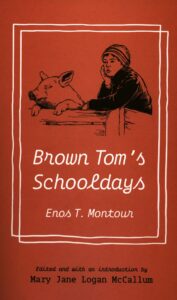Book review: Brown Tom’s Schooldays
 Reviewed by Karl Hele
Reviewed by Karl Hele
Brown Tom’s Schooldays is a marvellous fictionalized story of author Enos Montour’s experiences at the Mount Elgin Industrial School in the late 1910s as a young boy. Originally published in 1984, the 2024 edition is a valuable republication of the original along with a new forward, introduction, afterword, and appendices. Mary Jane McCallum’s introduction offers a thoughtful and thorough contextualization of the novel and its author. Elizabeth Graham, an anthropologist who initially worked with Montour to bring Brown Tom to print in 1984, offers her thoughts and reminiscences of the book, the man, and their relationship. Finally, the afterword by Montour’s granddaughters adds the personal and evocative nature of the original text and the complexity of the author’s life, relationships, and simple humanity.
McCallum’s introduction and detailed appendix offer the twenty-first century reader a pathway to understanding Brown Tom. She highlights the history of Mount Elgin, Montour, and the loosely fictionalized aspects of the novel (41-65). Likewise, the appendix allows readers to access the deeper meanings and references to Montour’s turns of phrase and his assumptions about the readership’s knowledge base (157-63). Overall, I found McCallum’s editorial hand and historical contextualizations useful. Both her introduction and appendices will allow the work to be used as a valuable teaching tool within highschool and university settings.
Montour’s novel gives life to the male student experience at residential school. Set in the mid to late 1910s, the story is unique and a prequel, of sorts, to Basil Johnston’s personal memoir of residential school life in the 1940s. Montour’s Brown Tom, is an allusion to the boys nineteenth-century adventure novel – Tom Brown. By reversing the title words, Montour is at once alluding to the nature of the story to be told, a boy’s adventure of sorts, and the fact it is not about white children (34-5). The novel begins with Tom drifting on the Muskegan River (aka the Thames River) studying for his final year exams while reminiscing of his school experiences. Subsequent chapters follow his admission to the school, his homesickness, work, his first crush, and fun as well as an epic barn fire and dramatic cattle rescue when the Muskegan flooded its banks. While never directly addressed, the novel does speak to the assimilative focus of the school as well as the impact of disease, death, hunger, and rigid routines. He also includes the small joys of being able to sneak away to a nearby corner store to purchase treats. The novel is an informative, thought provoking, and enjoyable read that explores the residential school experience through the eyes of a young boy. It is not written in a contemporary gritty style nor full of descriptive of violence within – this is after all the experiences of a child as seen through the eyes of a child written by a man from the generation that grew up prior to and during World War I. Nonetheless, Tom, much like Montour, holds ambivalent or mixed memories of his experiences – the hunger, humour, adventure, friendships, and adversity. Interestingly, the book ends with the same chapter title “Brown Tom ‘Arrives’”, hinting at the immense changes faced by the younger version of himself entering the school and now the older, wiser version, leaving. Both versions are arriving at particular destinations as they begin the next stage of their life path.
Brown Tom speaks to the complex nature of memory, experience, human nature, and colonialism. This is most evident when Tom speaks of his “Three Worlds” (86-92). The first is the comfort of home and the reserve. The second is the White world, that is strange, challenging, and filled with seemingly endless hustle and bustle. Finally, the third world was that of the school, something that was neither fully Indian nor White, but was dominated by cleanliness, order, and discipline.
According to McCallum, with which I agree, these three distinct ways of living offer “no neutral middle ground,” resulting in difficult choices that were “severe and violent” (62). These worlds Montour, his fictionalized self Tom, and all students had to navigate, as they stepped from the third world into either the first or second. These were stark choices offered to First Nation’s students by the colonial system as seen through a child’s eyes (62-3). These stark lines are evident throughout the novel, albeit the reader needs to pay attention for their presence, philosophical meanings, and lived realities for First Nations students.
Brown Tom is an excellent multi-facted exploration of youth, growing up, lived experiences, and Canadian colonialism through the eyes of a youth. It can be joyous, enlightening, sombre, and revelatory all within a few pages. McCallum’s introduction offers new insights into the novel and increases its teachability and relevance to classroom use. Overall, Brown Tom is a book that is readily accessible from the senior grade school to university classroom environment. Grade school students can be guided through the novel by teachers or parents who have read the introduction while university students can explore the novel independently through documents and story. I really enjoyed the novel and the new additions. It really is a must-read that offers complex insights into the Indian Residential School experience.
Enos T. Montour (ed. Mary Jane Logan McCallum), Brown Tom’s Schooldays. Winnipeg: University of Manitoba Press, 2024.
ISBN 1772840866


